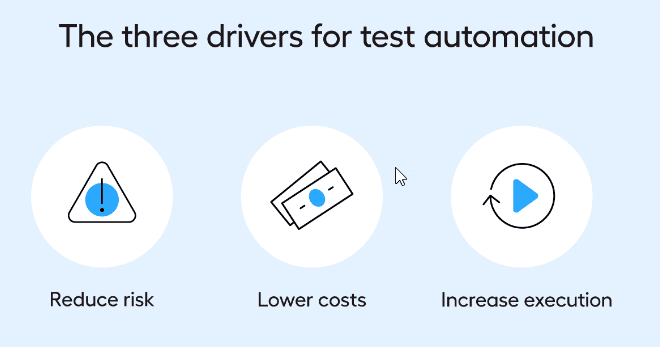Software testing is a crucial component of the software development lifecycle (SDLC) that helps ensure that a software product functions appropriately. The unfortunate truth? Traditional testing methods are no longer able to keep pace with the increasing speed of development. Time and money is wasted trying to test complex ecosystems manually.
That’s why software engineers are embracing automation to increase test coverage and efficiency. The best thing about automation testing is that it frees up major time and resources so you can focus on value-adding activities. The market for automated software testing is anticipated to reach $49.9 billion by 2026.
Why is automation important in software testing?
Organizations must continuously test their enterprise software to address the risk of business process failure in this era of customizable platforms and cloud-based ERPs. Automated testing is the fastest and most affordable method of doing so.
In a nutshell, the agile enterprise of today cannot be content with manual testing. The testing coverage is insufficient, it is expensive, and it takes a very long time to completely de-risk each crucial business process.
Learn more: Automation Testing vs. Manual Testing
Benefits of automated testing:
Top benefits of automation testing are listed below.
- Limiting exposure to risk: The average cost of application downtime per minute, according to Gartner, is $5,600/minute, or $300,000 an hour. Ouch.
- Automated testing evolves with your business: Manual testing techniques do not streamline repetitive tests cases. As an alternative, automated testing is more affordable over time because, once test scripts have been developed, they may be used indefinitely without incurring additional costs.
- Increased productivity: Software developers, QAs, and business users can spend less time in testing and more time on important activities because these tests can run repeatedly on their own.
- Automation testing enables continuous testing: Thanks to automated testing technologies, organizations may carry out continuous testing throughout the product lifecycle. This makes it possible for businesses to detect bugs faster. This is essential because, according to IBM, repairing a fault that is discovered late in the software lifecycle will cost 15 times more than fixing it earlier in the phase.
- Improved Return on Investment (ROI): Automation yields a high return on investment (ROI) and has been shown to significantly boost production and efficiency. By automating your test process, you can save money and time, which will help boost your return on investment over time.

Examples of Types of Testing
In specific scenarios, automation testing can be used most effectively. Here are a few situations when automated testing may be used:
Human or manual efforts: Imagine a situation where the QA team spends the majority of their time and energy on unit testing. Test automation frees them of that burden.
Repetitive testing: Automated testing is helpful when a product feature or process needs to be tested repeatedly.
End-to-end testing scenarios: Automated testing approach works best for systems that span many applications. Although end-to-end tests can cover a variety of technologies, their breadth depends on the business processes involved. End-to-end tests check for any modification or update in interconnected systems, and provide a thorough evaluation of all stages of a software process. In e-commerce, for example, an end-to-end test would monitor every step of an interaction, from a customer clicking the ‘order’ button to the manufacturer shipping the product. Automation rapidly speeds up this type of testing. Opkey provides “one-click” test capability, as well as self-healing tests that automatically deal with problems that arise.
Business-critical applications: Any organization’s operations are centered on its business-critical apps. Automation testing is a secure and trustworthy replacement for manual testing when delivering high-quality applications.
Continuous testing: Automation testing is ideal for continuous integration and delivery (CI/CD) since it can run continuously. This approach eliminates the need for manual integration of incremental code changes into production.
How to Select Your Tool
Software test automation involves the use of an automated tool to minimize the need for human intervention and increase speed, reliability, and efficiency. Effective automated testing requires selecting the appropriate tool for every requirement and need.
Code-based test automation tools
As a business expands, new features are added and customizations are made. All of these changes need to be tested. You need resources to maintain your code-based frameworks to keep up with the increased demand for testing. With increasing maintenance costs, test automation loses value and becomes more difficult to scale.
No-code automation tools
By using an automation tool that doesn’t require coding, teams may swiftly overcome the challenges presented by code-based solutions and enjoy the benefits of automation.
- No-code automation tools basically employ a record and playback engine that mimics the user actions. So you don’t need to write the test scripts manually. Thus they reduce your effort and time significantly.
- No-code tools scale and work across platforms, allowing teams to expand the breadth of test automation.
- No-code test automation tools streamlines documentation and reporting procedures by automatically logging tests and making them easier to evaluate.
- Because developers don’t need to learn how to automate, testers don’t need to spend their time learning how to code, which frees up resources and allows for better testing at cheaper prices.
- Due to all the aforementioned advantages, no-code testing tools accelerates the release pipeline and helps CI/CD by enabling much more effective testing.
Learn more: Automation Testing Tools: Which One Is Right for You
Automation testing is crucial because it helps businesses achieve their testing objectives with a high return on investment. To successfully embark on a test automation journey, an organization must first choose a comprehensive test automation platform, such as Opkey, that includes various testing tools and a no-code testing framework.








